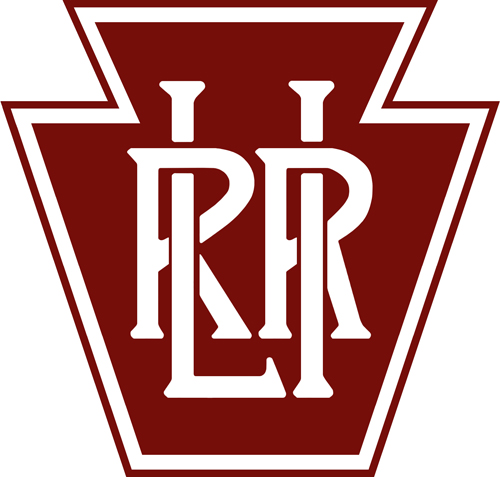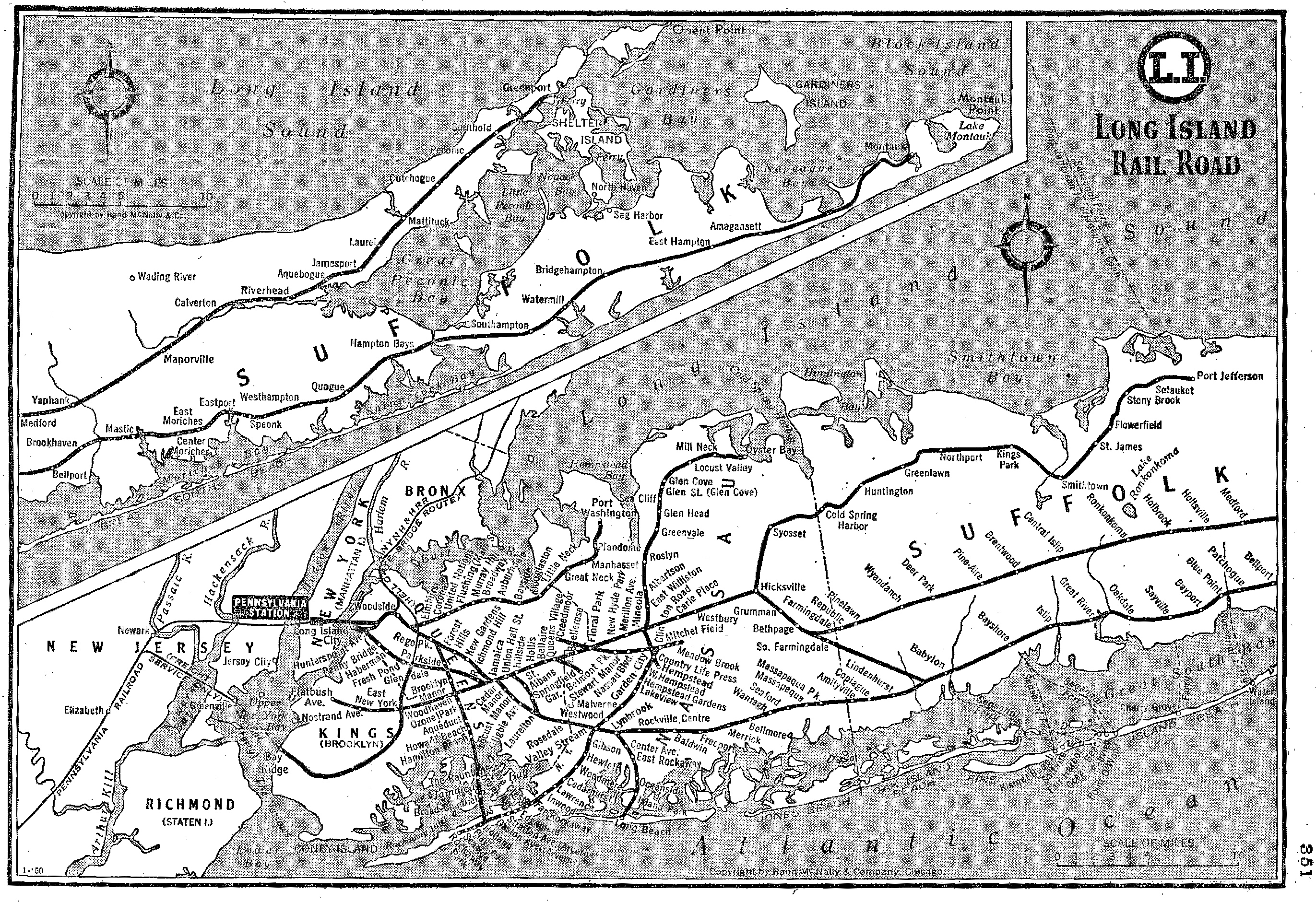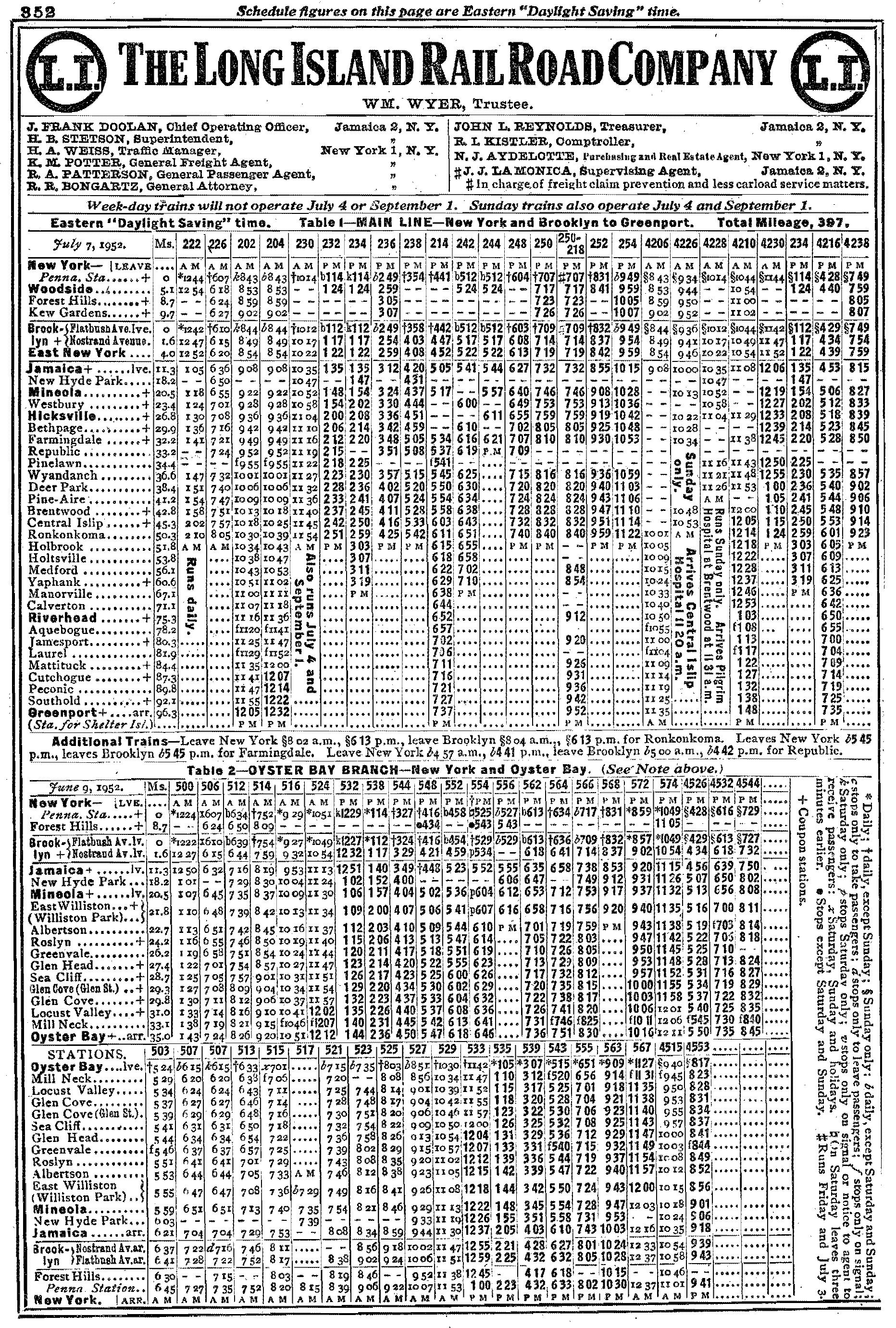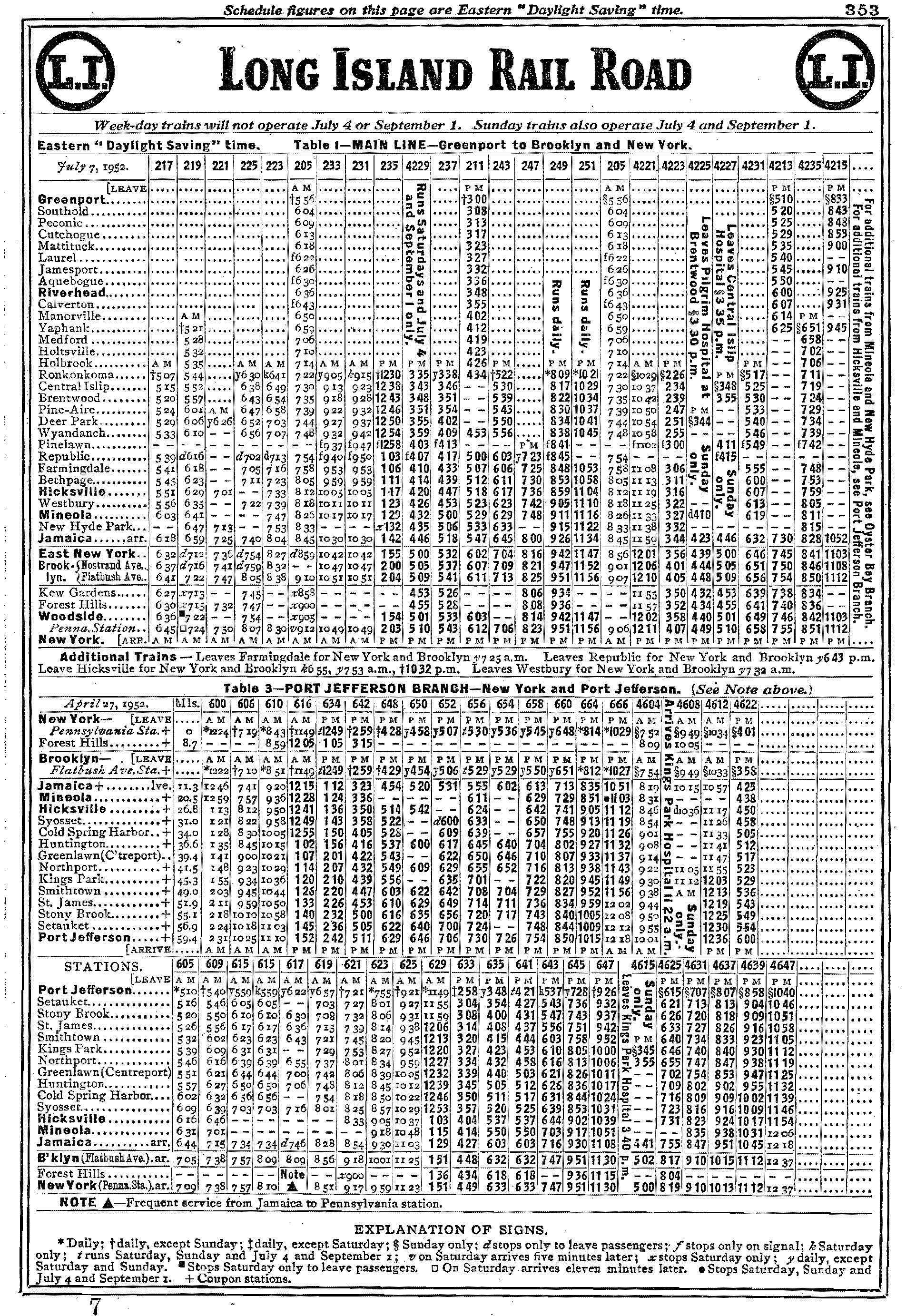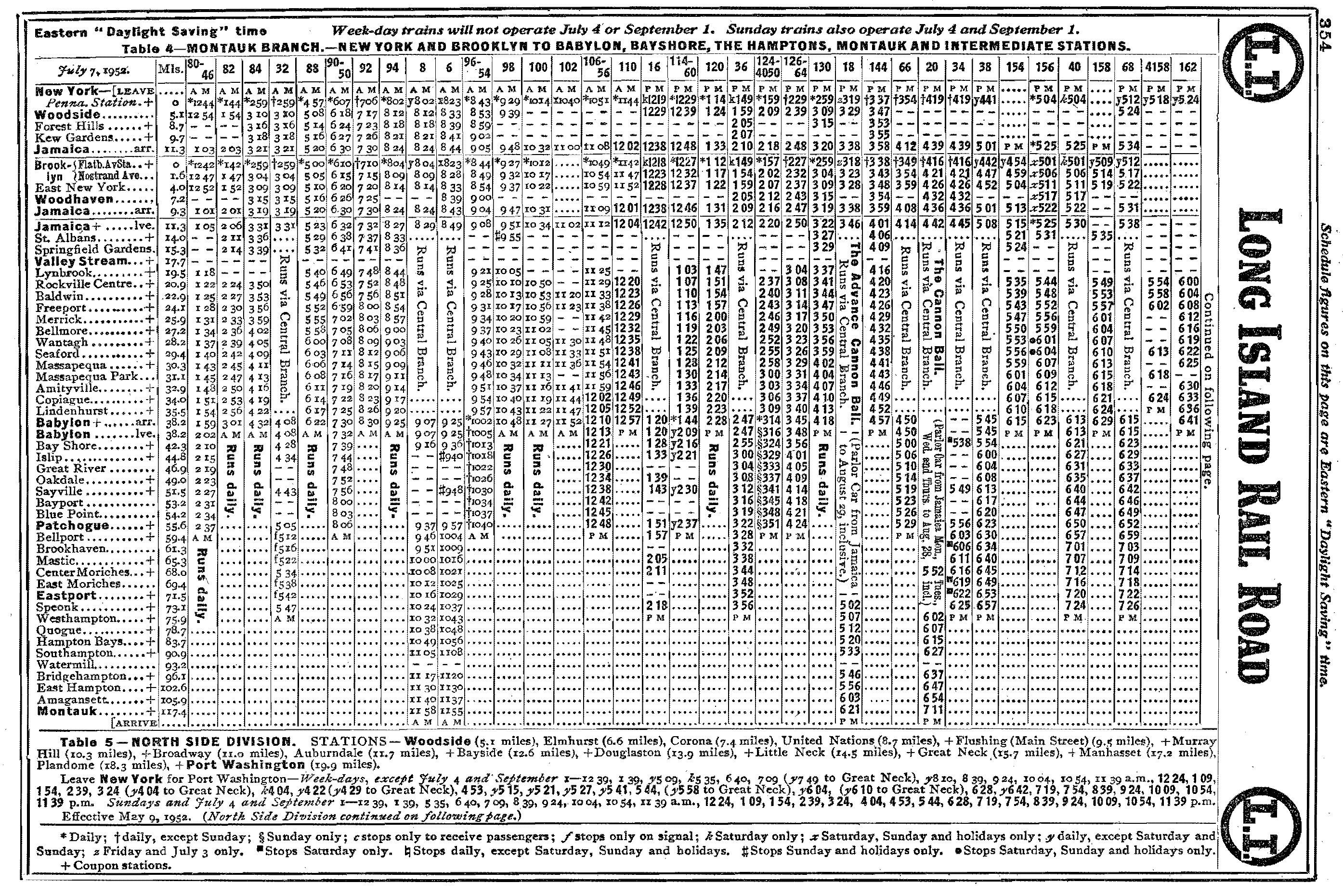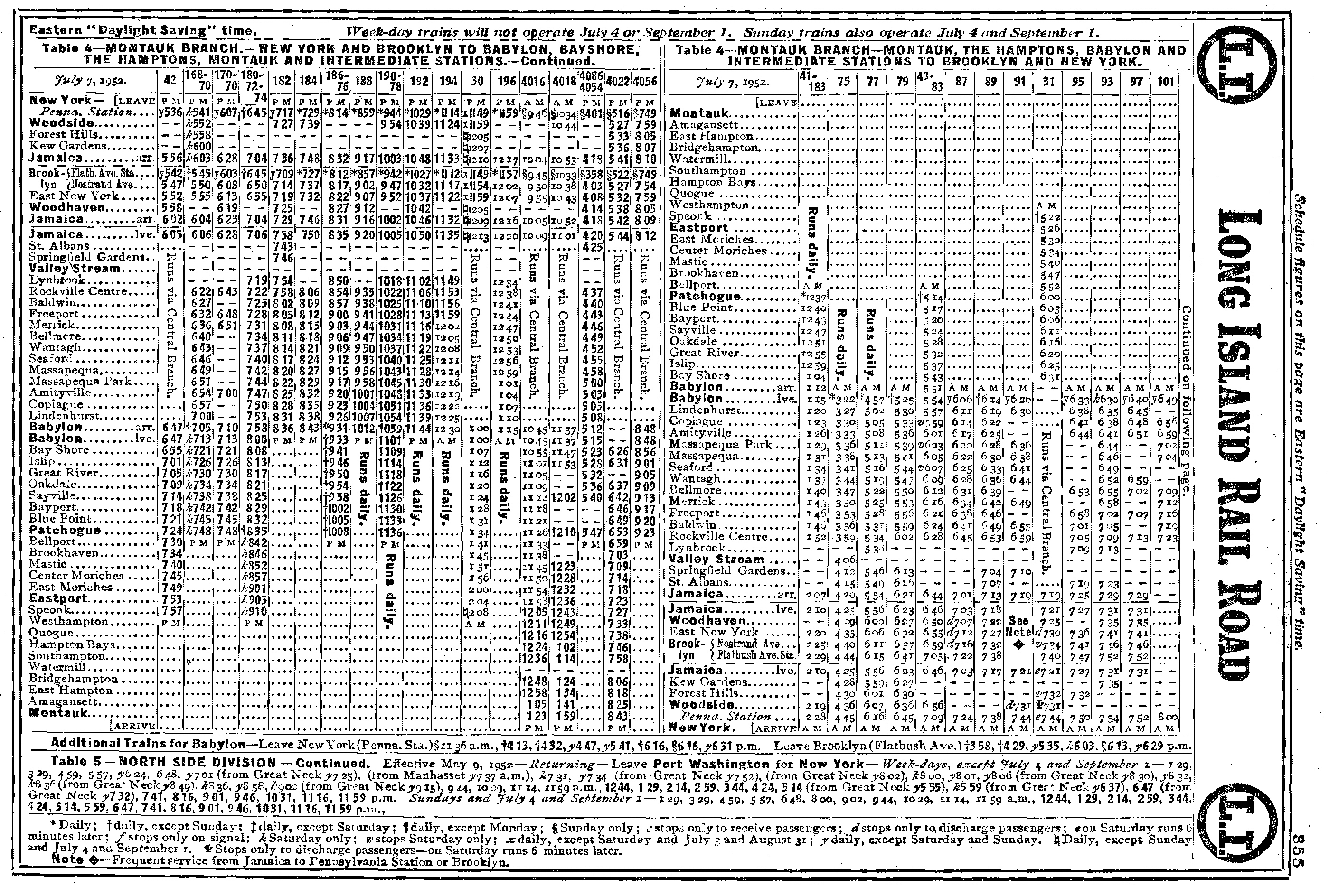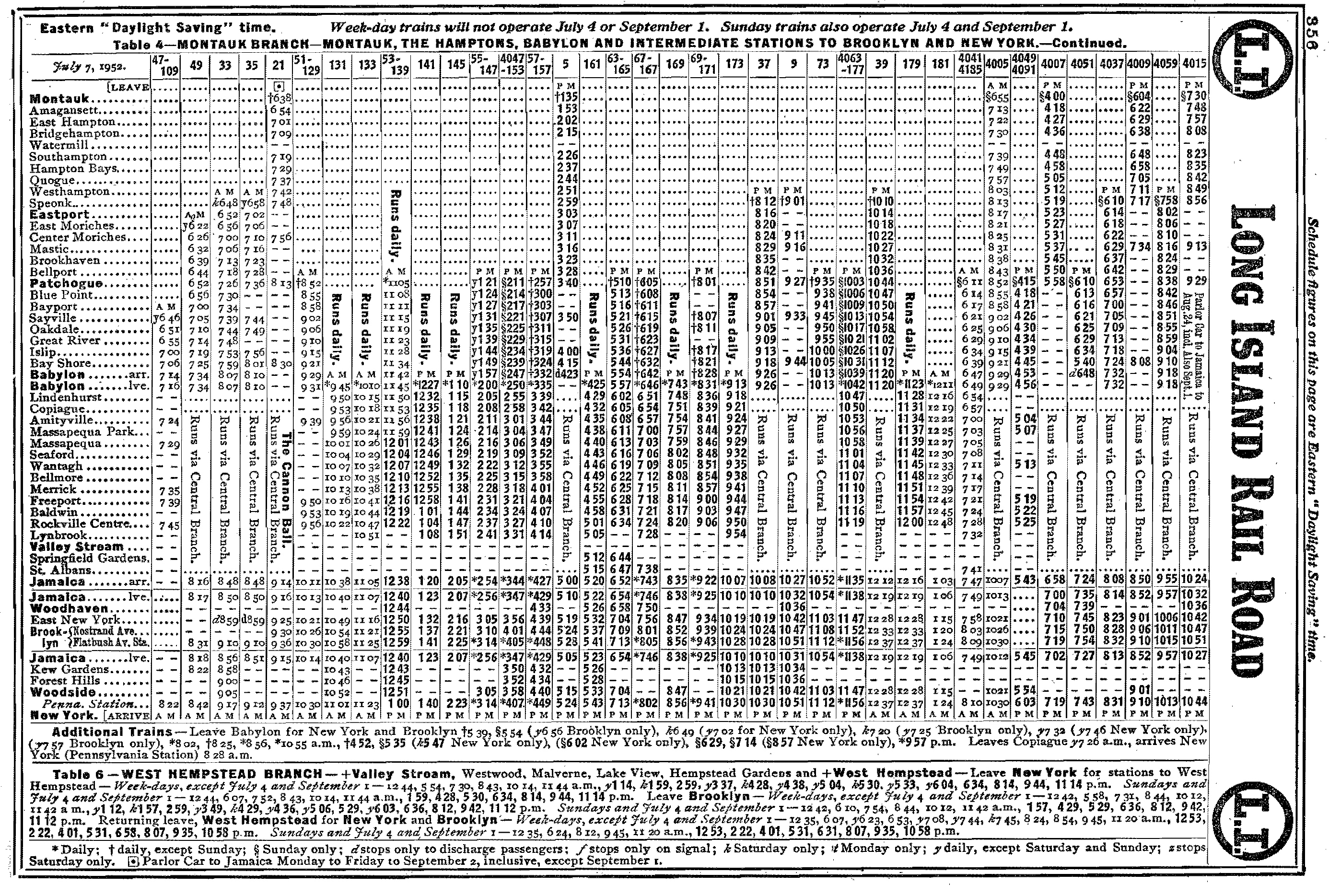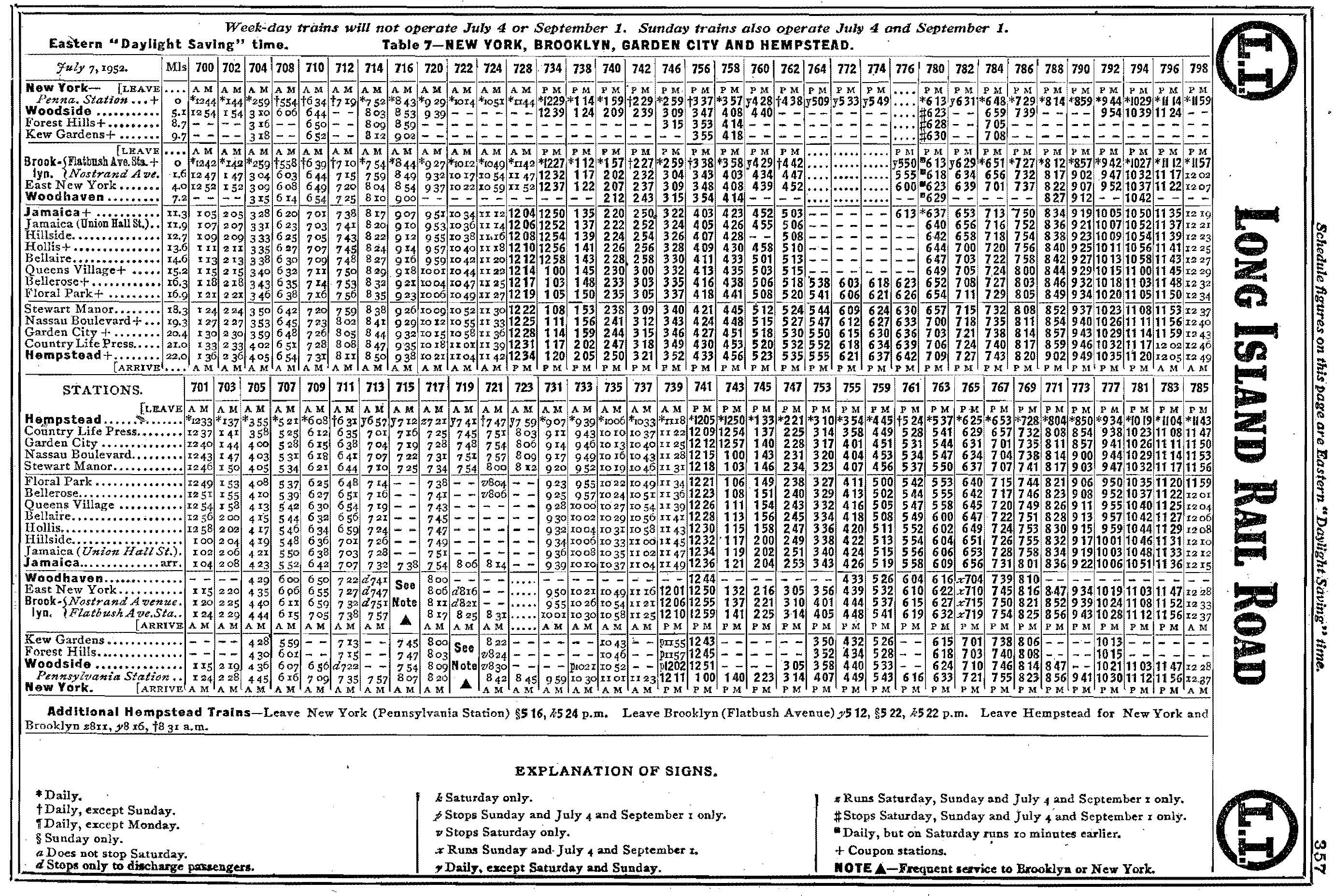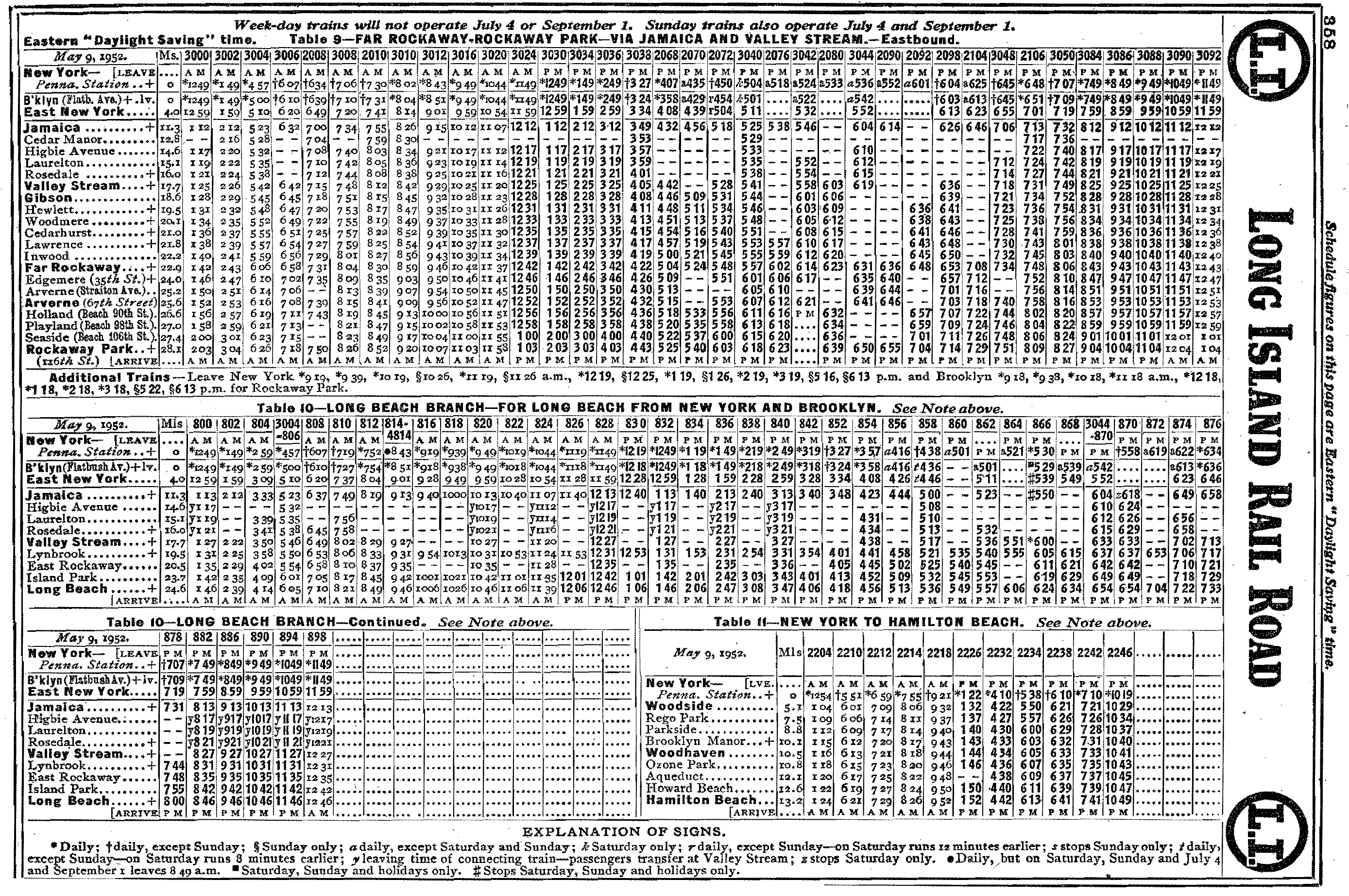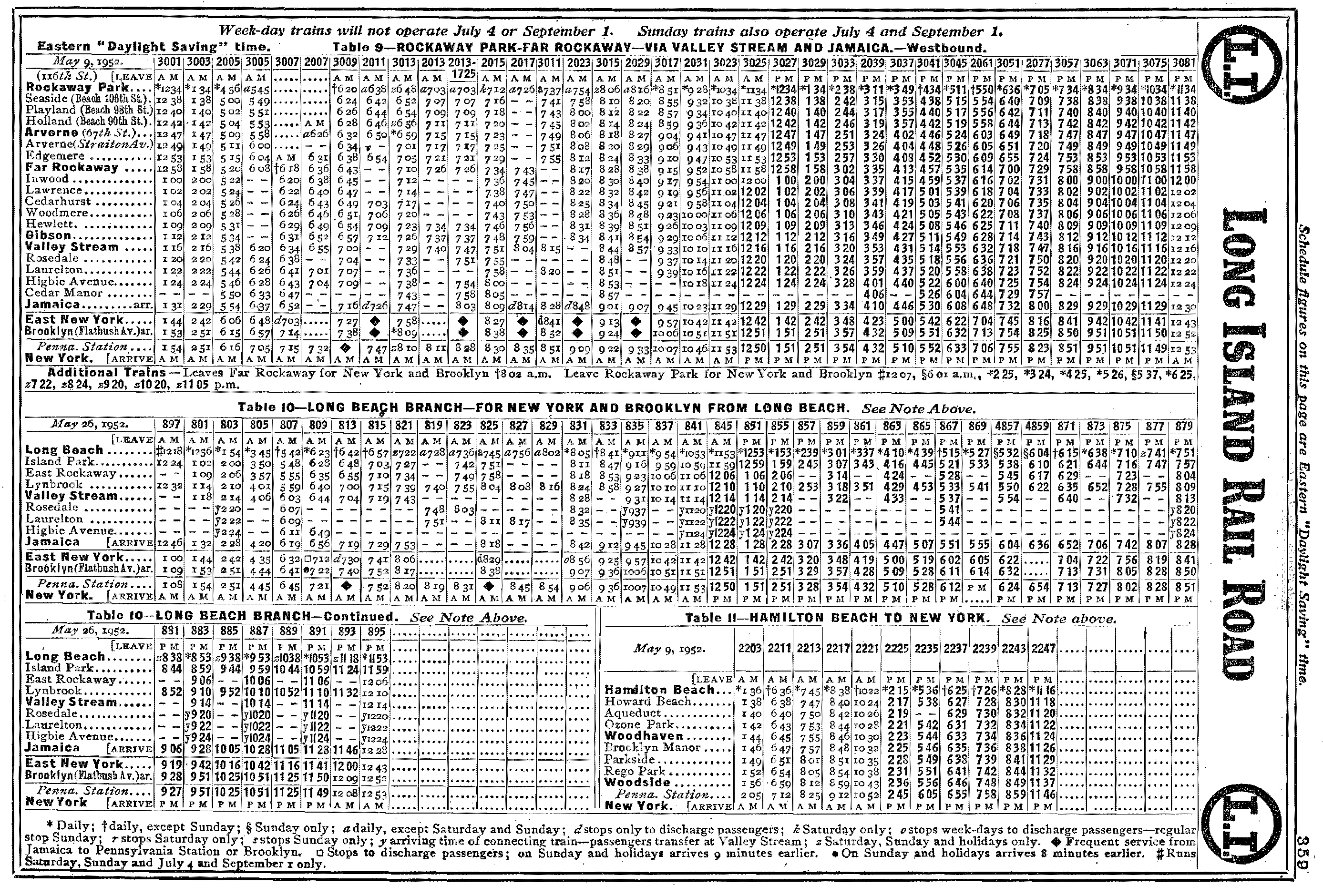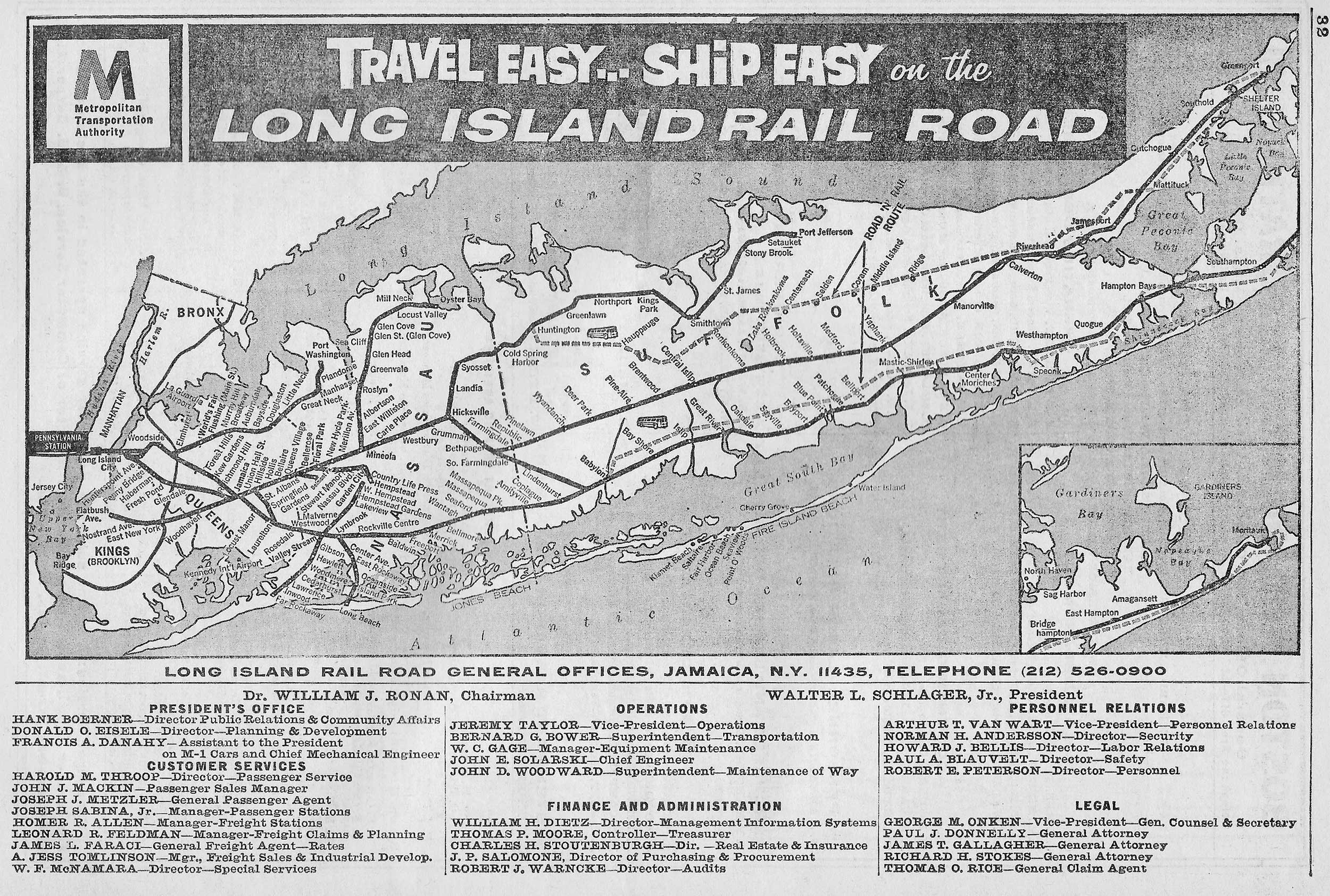Long Island Rail Road: "Route Of The Dashing Commuter"
Last revised: August 23, 2024
By: Adam Burns
The Long Island Rail Road (as-spelled) is one of the oldest still in operation today with a charter dating back to the 1830s!
Today's LIRR has lost any semblance of independence; as a ward of the Metropolitan Transportation Authority (MTA) it provides commuter rail service between its home island and our nation's largest city.
The "Route Of The Dashing Commuter" may seem like just another suburban railroad but it carries a rich history of serving Long Island utilizing an eclectic fleet of locomotives.
The current system provides only passenger service while freight is now handled by the New York & Atlantic Railway, a private subsidiary of Anacostia & Pacific.
The LIRR currently maintains over 300 miles, serves 124 stations, and transports more than 300,000 weekday commuters across its system.
The "glory days" of the LIRR, a brief summary of which is presented here, may be behind it but the railroad remains an important transportation artery for the New York region.
Photos
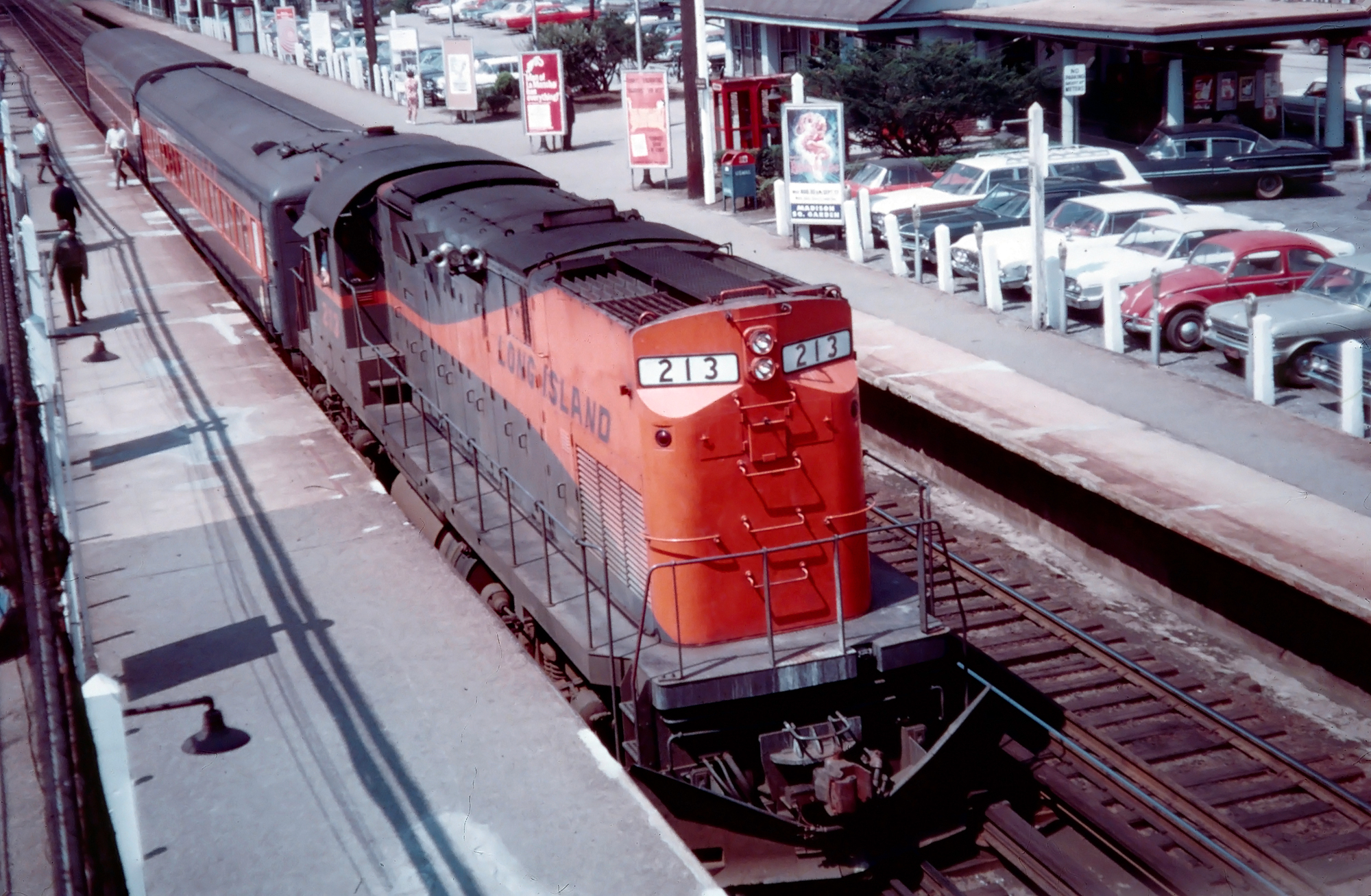 Long Island Rail Road C420 #213 is seen here stopped at Mineola, New York in 1964. American-Rails.com collection.
Long Island Rail Road C420 #213 is seen here stopped at Mineola, New York in 1964. American-Rails.com collection.History
In the latter 19th century Long Island blossomed into a bustling suburb of New York City containing commercial districts, pristine beaches, and even forested state parks within its 1,400 square miles.
It may be surprising to know that as late as the Civil War period it remained largely uninhabited except for local agricultural use.
At A Glance
Long Island City - Hunterspoint Avenue - Jamaica Long Island City - Woodside - Elmhurst - Jamaica Elmhurst - Port Washington Flatbush Avenue - Woodhaven - Jamaica Jamaica - Hicksville Mineola - Oyster Bay Jamaica - Lindenhurst - Westhampton - Montauk Far Rockaway - Valley Stream - West Hempstead Lynbrook - Long Beach Hicksville - Babylon Hicksville - Port Jefferson Hicksville - South Farmingdale - Greenport | |
However, that changed towards in the following decades when improved transportation (ferries, trolleys, and streetcars) witnessed evermore folks journeying to the island.
Some came to escape the hectic city life while others vacationed at the beaches. The LIRR's earliest history dates back to April 25, 1832 when the Brooklyn & Jamaica Railroad Company was incorporated to connect Brooklyn and Jamaica, a distance of ten miles. It was the first railroad on Long Island and opened on April 18, 1836.
Interestingly, the B&J never actually commenced operations under its own name or management. On April 24, 1834, the Long Island Rail Road Company was formed by investors in New York and Boston to lease the B&J and continue pushing rails eastward.
Logo
Expansion
The LIRR planned a route through the island's center and terminate at the eastern tip near Greenport. From there, steamship service (provided by Cornelius Vanderbilt's company, he would later sit on the railroad's board) was employed across Block Island Sound to interchange freight and passengers with the Old Colony Railroad at Stonington, Connecticut.
This line handled the business to Providence, Boston, and other points in New England. The LIRR's promoters felt their railroad held true promise given that engineers believed an all-terrain rail route between New York and Boston, running the southern shores of Connecticut and Rhode Island, was an impossibility due to the topography and river valleys.
Unfortunately, this theory proved incorrect as predecessors of the later New York, New Haven & Hartford did open rail service to New York prior to 1850.
This route became part of the New Haven's "Shore Line," handling thousands of commuters, and heavy freight tonnage, on a daily basis. Today, it remains a busy component of Amtrak as part of the Northeast Corridor (NEC).
Timetables (1952)
The LIRR's promoters further erred when they engineered a line through the island's uninhabited center instead of running closer to the more widely settled northern shore.
The central region contained easier grades but the coastline offered greater freight and passenger potential. In short, the original vision for the Long Island Rail Road proved a failure. However, the road would rebound from this early gaffe.
On July 27, 1844 the 96-mile route between Brooklyn and Greenport was completed with special excursions held to mark the occasion (official service commenced on July 29th).
According to Rae Ediger's article, "Long Island Rail Road" from the March, 1949 issue of Trains Magazine, the rail-water route reduced the previously all-water trip between New York and Boston from sixteen hours to about eight.
Its first two locomotives, named the Ariel and Postboy (products of Baldwin originally built for the B&J), handled initial duties. However, by 1844 its fleet had blossomed to eleven locomotives and the future appeared bright.
In 1848 the New York & New Haven opened between its namesake cities, providing through service to Boston (it later built a more efficient, southerly connection to New England's largest city).
With an all-land route now available, the LIRR's faded and fell into bankruptcy on March 4, 1850 emerging on January 25, 1851 carrying the same name.
To achieve success the LIRR knew it must focus on providing local passenger and commuter services. To do this it received an amendment to its charter on April 21, 1862 authorizing construction anywhere east of Jamaica.
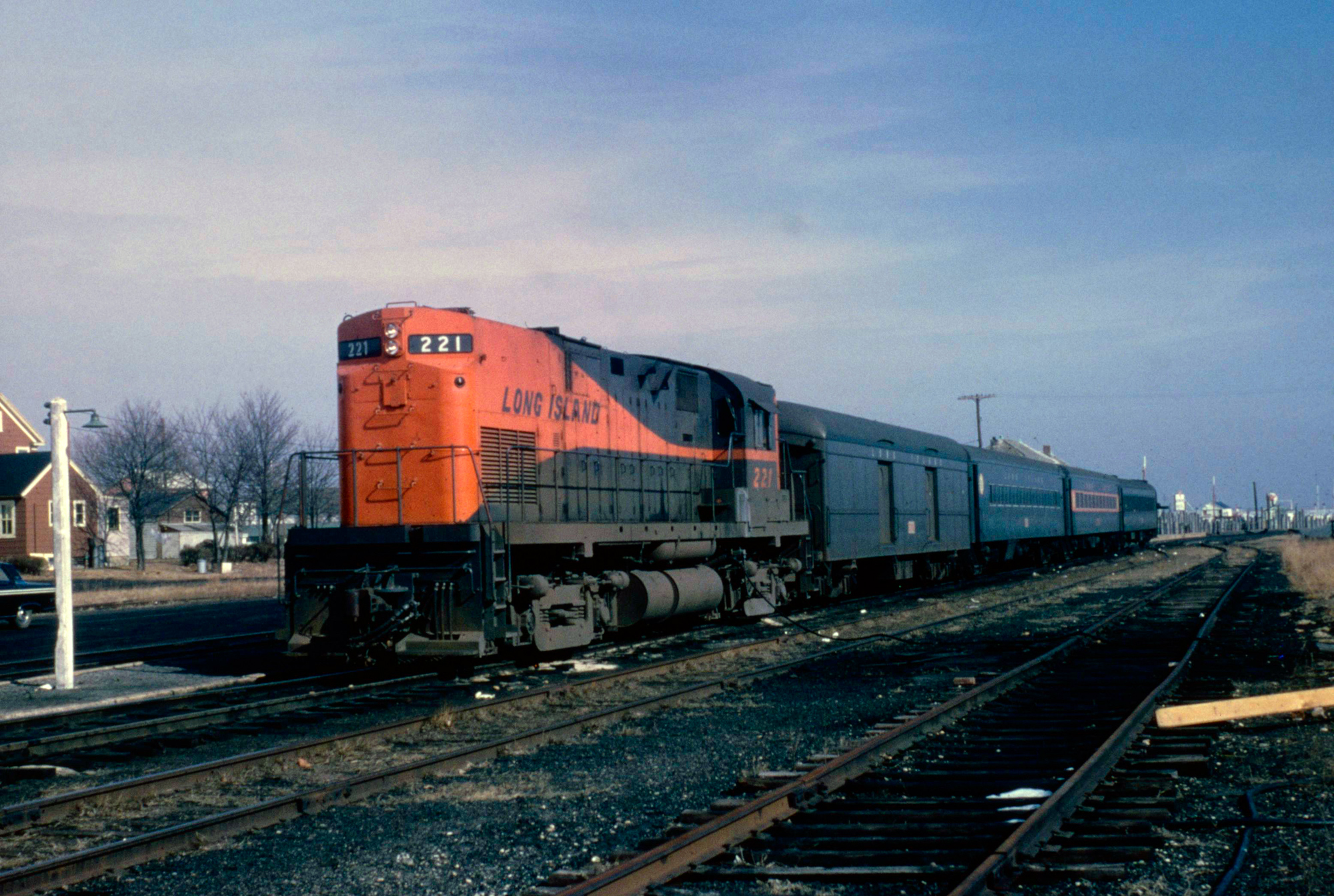 Long Island Rail Road C420 #221 is taking on water at the end of the line in Greenport, New York during a late fall day in the 1960s. Author's collection.
Long Island Rail Road C420 #221 is taking on water at the end of the line in Greenport, New York during a late fall day in the 1960s. Author's collection.With this allowance the company set about connecting all of Long Island's largest communities, whisking patrons westward to catch ferries to Manhattan Island.
On November 7, 1853 the Hicksville & Cold Spring Branch Railroad was chartered to build an extension from Hicksville to Cold Spring Harbor.
It was soon leased by the LIRR and opened to Syosset in 1854. Following disagreements and delays the project was not completed to Northport until April 15, 1868.
"Firsts" In Railroading
In 1959 the LIRR published a booklet celebrating its 125th anniversary. Within it was a series of industrial "firsts." These accomplishments included the following:
First to use the now-standard hooked track spike (1836).
First to install a steam whistle on a locomotive (1836).
First to use "piggyback," hauling farm wagons on flatcars (1885). [It is somewhat confusing what the railroad meant by this achievement.
The industry's term of "piggyback" most often refers to trailer-on-flat-car, or TOFC, service regarding the haulage of truck trailers. Automobiles, of course, were not invented until the early 20th century and the first experimentation with TOFC began decades later].
First to use an all-steel passenger car (1905).
First to install extensive main line electrification (1905).
First to use a diesel locomotive in road service (1926).
First to use modern mercury-arc rectifiers to supply third-rail current (1926).
First to have an all-steel passenger fleet (1927).
First to install completely remote-controlled electrical substations (1930).
First to use electronic rail defect detector cars to spot invisible flaws in rail (1931).
First to use fully-electronic, constant service, high-speed automatic speed control system (1951).
First railroad to install completely automatic IBM inventory control (1958).
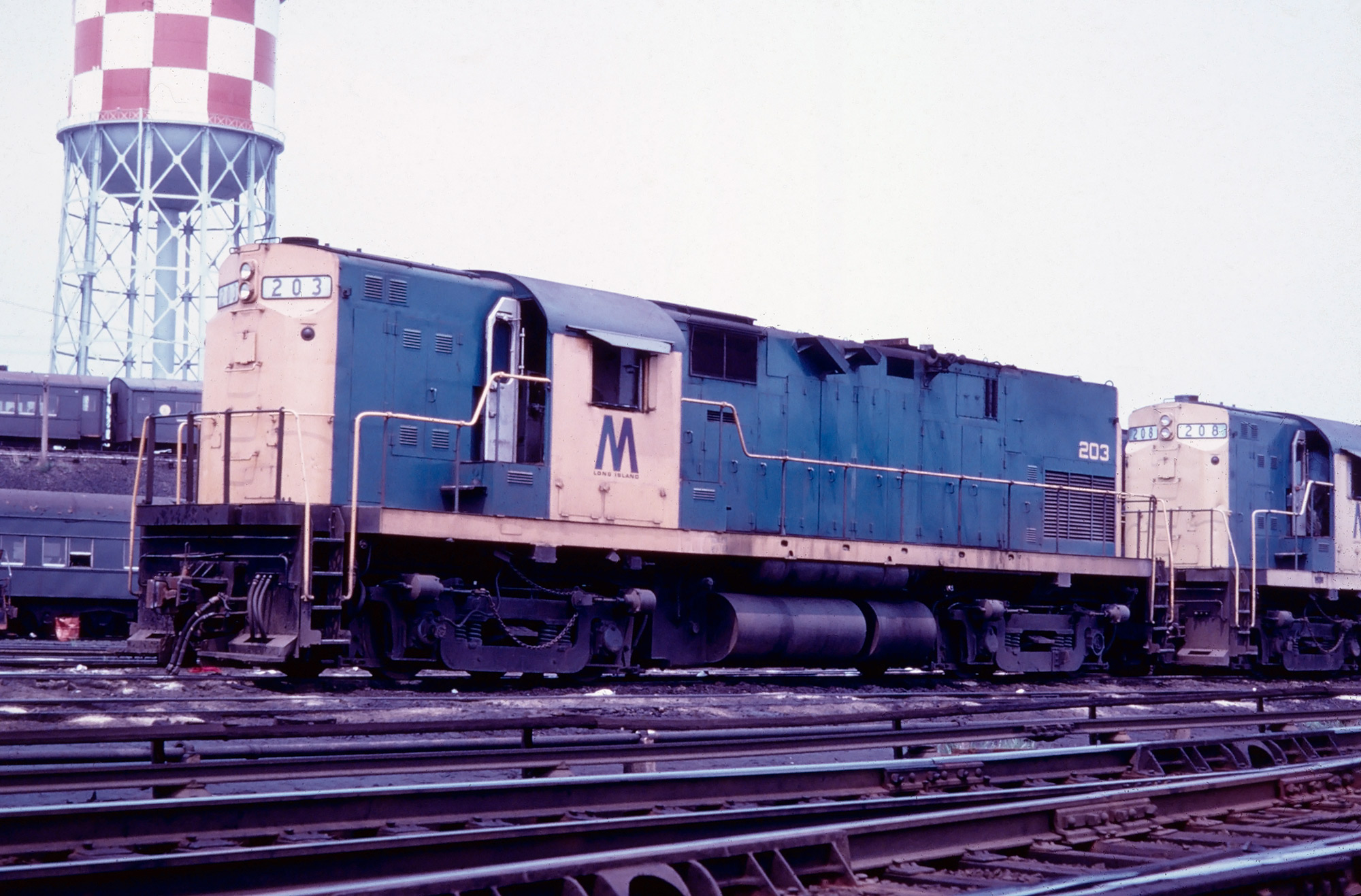 Long Island Rail Road C420s #203 and #208 were photographed here at the yard in Jamaica, New York in 1970. American-Rails.com collection.
Long Island Rail Road C420s #203 and #208 were photographed here at the yard in Jamaica, New York in 1970. American-Rails.com collection.Soon after this branch opened an extension built as the Smithtown & Port Jefferson Railroad. This subsidiary was organized in 1870 and pushed service to Port Jefferson, opening on January 13, 1873.
The years following the Civil War contained a flurry of construction activity with the completion of the Locust Valley Branch (Oyster Bay Branch) on April 19, 1869 and Sag Harbor Branch (via Manorville) on May 9, 1870. In addition, the acquisition of several smaller projects made the LIRR the dominant railroad on Long Island.
In 1880 Austin Corbin acquired control and took the company to even further heights. It completed a second main line hugging the southern shore of the Atlantic Ocean (known as the Brooklyn & Montauk Railroad it opened in 1881).
There were also branches laid to Manhattan Beach (opened on July 19, 1877), Long Beach (completed in 1880), Far Rockaway (finished in 1869), and Port Washington (opened in 1898).
By the turn of the 20th century the Long Island Rail Road had bought out all of its competitors and was the only rail service available on the island.
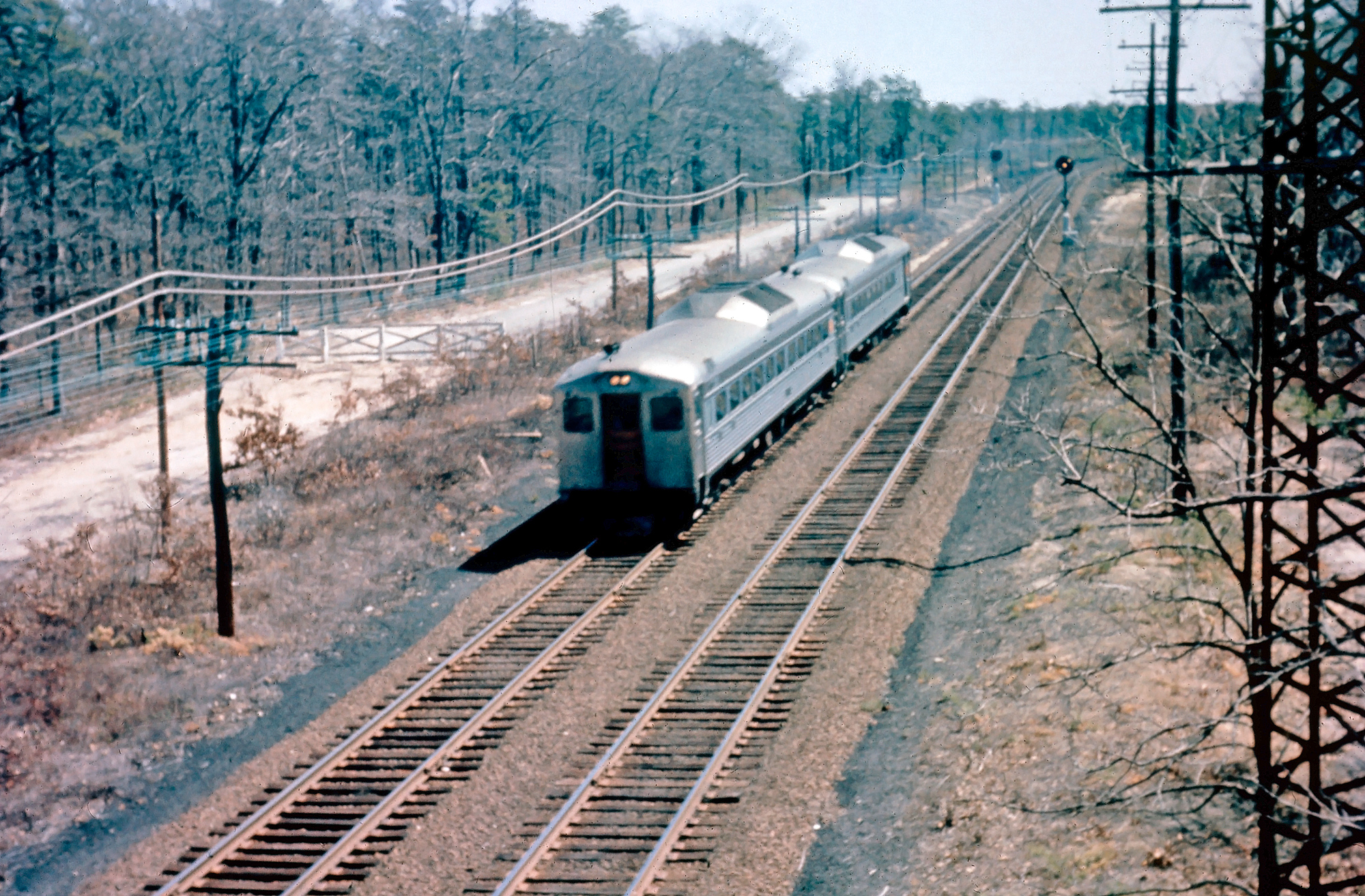 Long Island Rail Road RDC-1's #3101 and #3121 in "Scoot Service" near Oakdale, New York, circa 1957. Meyer Pearlman photo. American-Rails.com collection.
Long Island Rail Road RDC-1's #3101 and #3121 in "Scoot Service" near Oakdale, New York, circa 1957. Meyer Pearlman photo. American-Rails.com collection.At the same time, in 1900, the LIRR came under the Pennsylvania Railroad's control, acquiring it for $6 million.
The Pennsy's takeover was part of a long range plan under new PRR president Andrew Cassatt to not only dominate rail service throughout New York but also provide efficient commuter service across the region.
It all began when the PRR laid the groundwork for its magnificent Pennsylvania Station in downtown Manhattan, a project launched in 1901.
While the new terminal would provide the railroad with direct service into New York's downtown district it was also designed to handle extensive commuter traffic.
The PRR's new Long Island subsidiary would be incorporated into the station's master plan via four tunnels beneath the East River for direct rail service into the facility (two would also built under the Hudson to connect with the Pennsy's main line at Newark, New Jersey).
The tunneling began in 1902, spearheaded by engineer Samuel Rea (who later became PRR's president) with assistance from Charles Jacobs, an expert in tunnel construction and engineering.
The entire project encompassed 16 miles of underground rail lines, a massive undertaking for a private company; on September 11, 1906 the Hudson River Tunnels (also known as the North River Tunnels) were completed a full year ahead of schedule although those bored beneath the East River were much more difficult and required a few more years of work.
They were not finished until 1909. The grand Pennsylvania Station opened to the public during two stages in 1910; the LIRR commenced service on September 8th while the terminal officially opened for all rail traffic on November 27th.
According to David Morgan's article, "Long Island: Which Plan D'Ya Read" from the December, 1952 issue of Trains Magazine, the tunnels enabled the LIRR to discontinue nine ferries and finally connect it with the national rail network.
System Map (1969)
The PRR improved its subsidiary in other ways; nearly 30% of the LIRR's network was electrified, all-steel cars were purchased (it is historically noteworthy as being the first railroad to boast all-steel rolling stock, retiring its last wooden car in 1927), grade crossings removed, and the physical plant heavily upgraded.
At is peak the Long Island Rail Road operated a network of 378 route miles. Mr. Ediger's article notes that during this period the company operated 813 daily passenger trains during the summer and 746 during the winter.
For years it held a unique place within the industry as the only Class I whose passenger income far surpassed freight earnings.
In 1941, for instance, its total annual revenue was $25.4 million; of this, $16.5 million was from passenger traffic while freight comprised only $8.9 million. Unfortunately, PRR control did not last. The LIRR had remained a profitable operation from the time of Pennsy's takeover until the Great Depression.
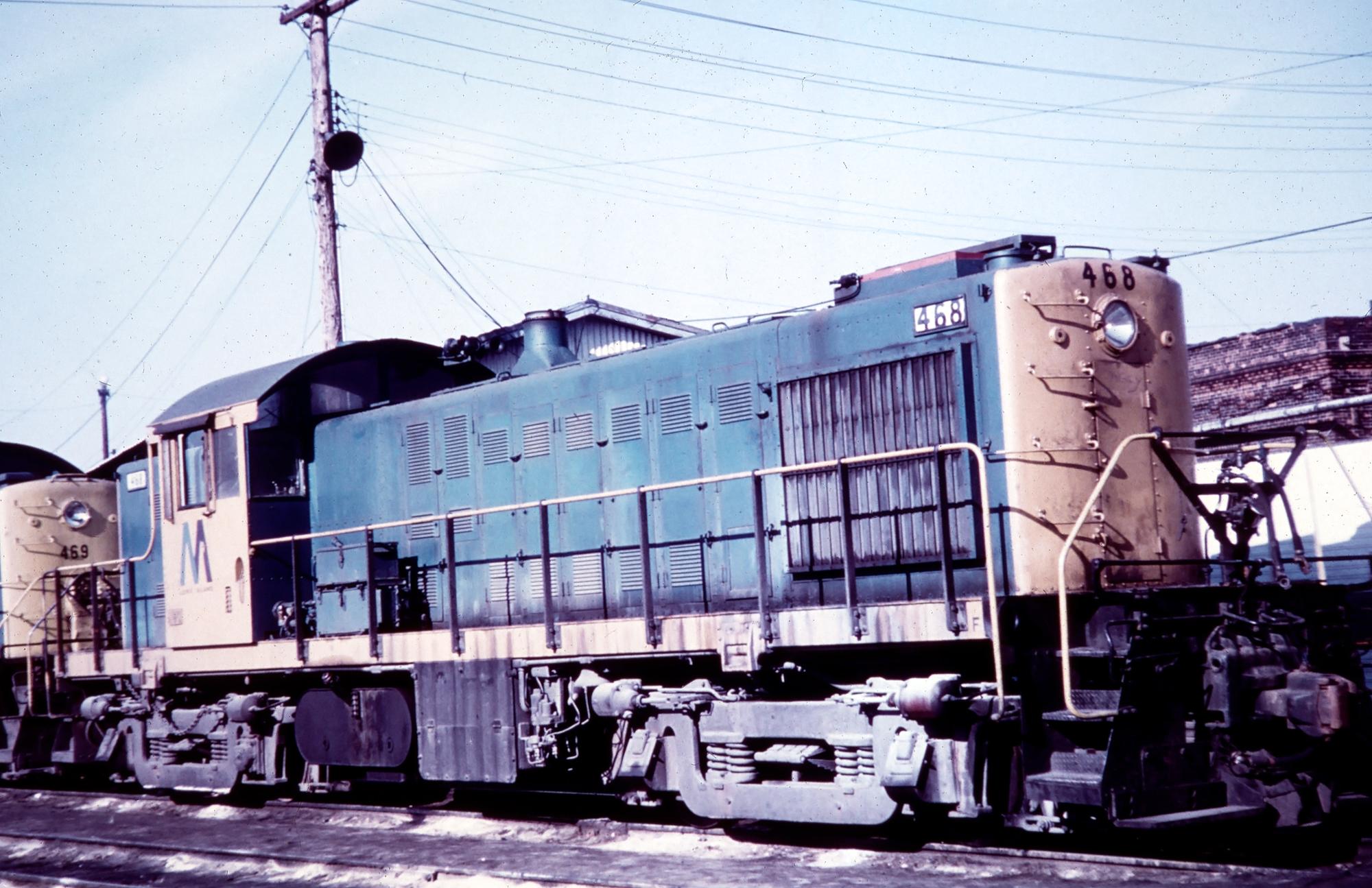 Long Island Rail Road RS1 #468 was photographed here at Morris Plains, New York in 1971. This unit was one of nine the LIRR acquired between 1948-1950, numbered 461-469. American-Rails.com collection.
Long Island Rail Road RS1 #468 was photographed here at Morris Plains, New York in 1971. This unit was one of nine the LIRR acquired between 1948-1950, numbered 461-469. American-Rails.com collection.Locomotives
If you were a railfan in the New York area during the 1950s the Long Island Rail Road was a fascinating operation to witness in person, especially if you caught it before the steam locomotive made its final run on October 8, 1955.
The LIRR maintained a varied fleet of steamers, ranging from 4-4-2's to 2-8-0's, although it largely relied on beefy 4-6-0's it was provided by parent PRR.
These were classed as G5s and offered quick acceleration along with plenty of power for the many start-and-stops inherent in commuter services.
After World War II the LIRR began purchasing models from the American Locomotive Company (Alco), Baldwin, and even Fairbanks-Morse such as the rare CPA20-5 "C-Liner" (FM) and Alco's popular Road-Switcher (RS) designs. Ironically, it did not acquire its first Electro-Motive models until the 1970s, comprised mostly of GP38-2's in 1977.
The reasons for the road's issues were many ranging from rising operating costs to the general economic downturn of the 1930s. In addition, the state itself was to blame.
Mr. Morgan's article notes the New York Public Service Commission forbade the LIRR from raising commutation fares for nearly three decades (1918-1947) despite the fact that taxes, alone, had increased from $1.4 million in 1921 to $3.8 million by 1948.
Finally, the road's business was further hurt by the expansion of New York's subway system and an ever-increasing number of roads and bridges.
The Pennsy, which posted losses for the first time in its history during 1946, could no longer afford to underwrite its subsidiary.
It announced on February 2, 1949 the Long Island Rail Road would enter bankruptcy, formally carrying out the declaration on March 2nd. This largely freed the PRR from its money pit although it still retained ownership of the property.
With the Pennsy refusing to continue financial support, the state was left to decide the LIRR's fate. In one of the few instances of public awareness recognizing a railroad's importance prior to the 1980s, New York began subsidization efforts during the 1950s.
By this time the LIRR had fallen into a decrepit state with aging equipment and infrastructure. Because of this it earned considerably bad publicity when deadly accidents occurred at Rockville Centre, Huntington, and Richmond Hill killing a total of 115 people.
The state provided $60 million through the 1960s for new rolling stock, electric MU cars, locomotives, and infrastructure upgrades.
On January 20, 1965, New York made formal efforts to acquire the property from the PRR, creating the Metropolitan Transportation Authority (MTA) to do so. The new agency formally took control during August of 1966.
Today
Today, the LIRR's electrified network is entirely third-rail and the railroad continues to operate the famous Cannonball passenger train, serving the Hamptons between May and September.
Steam Roster
The below roster is dated effective as of 1949, a few years before the LIRR retired its fleet in favor of diesels.
| Wheel Arrangement | Class | Quantity | Service Type | Notes |
|---|---|---|---|---|
| 2-8-0 (Consolidation) | H-6sb | 4 | Freight | |
| 2-8-0 (Consolidation) | H-10s | 19 | Freight | |
| 4-4-2 (Atlantic) | E-6s | 4 | Passenger | Leased From PRR |
| 4-6-0 (Ten-Wheeler) | G-53ds | 3 | Passenger | |
| 4-6-0 (Ten-Wheeler) | G-5s | 31 | Passenger | |
| 4-6-2 (Pacific) | K-4s | 13 | Passenger | Leased From PRR |
| 0-6-0 (Switcher) | B-8 | 2 | Yard Duty | Leased From PRR |
| 0-8-0 (Switcher) | C-51s | 2 | Yard Duty | |
| 0-8-0 (Switcher) | C-51sa | 11 | Yard Duty |
Diesel Roster
American Locomotive Company
| Model Type | Road Number | Date Built | Quantity |
|---|---|---|---|
| C420 | 200-229 | 1963-1968 | 30 |
| Boxcab | 401-402 | 1925-1928 | 2 |
| S1 | 404-408, 413-421 | 1946-1949 | 14 |
| S2 | 446-460 | 1948-1949 | 15 |
| RS1 | 461-469 | 1949-1950 | 9 |
| RS3 | 1551-1560 | 1955 | 10 |
Baldwin Locomotive Works
| Model Type | Road Number | Date Built | Quantity |
|---|---|---|---|
| VO-660 | 403 | 1945 | 1 |
| DS-4-4-660 | 409-412 | 1948 | 4 |
| DS-4-4-1000 | 450 | 1948 | 1 |
Electro-Motive Division
| Model Type | Road Number | Date Built | Quantity |
|---|---|---|---|
| SW1001 | 100-107 | 1977 | 8 |
| MP15AC | 150-172 | 1977 | 23 |
| GP38-2 | 250-277 | 1976-1977 | 28 |
| DE-30AC | 400-422 | 1998 | 23 |
| DM-30AC | 500-522 | 1998-1999 | 23 |
Fairbanks-Morse
| Model Type | Road Number | Date Built | Quantity |
|---|---|---|---|
| H16-44 | 1501-1509 | 1951 | 9 |
| CPA20-5 (C-Liner) | 2001-2008 | 1950 | 8 |
General Electric
| Model Type | Road Number | Date Built | Quantity |
|---|---|---|---|
| 25-Tonner | 398-399 | 1958 | 2 |
| 44-Tonner | 400 | 1950 | 1 |
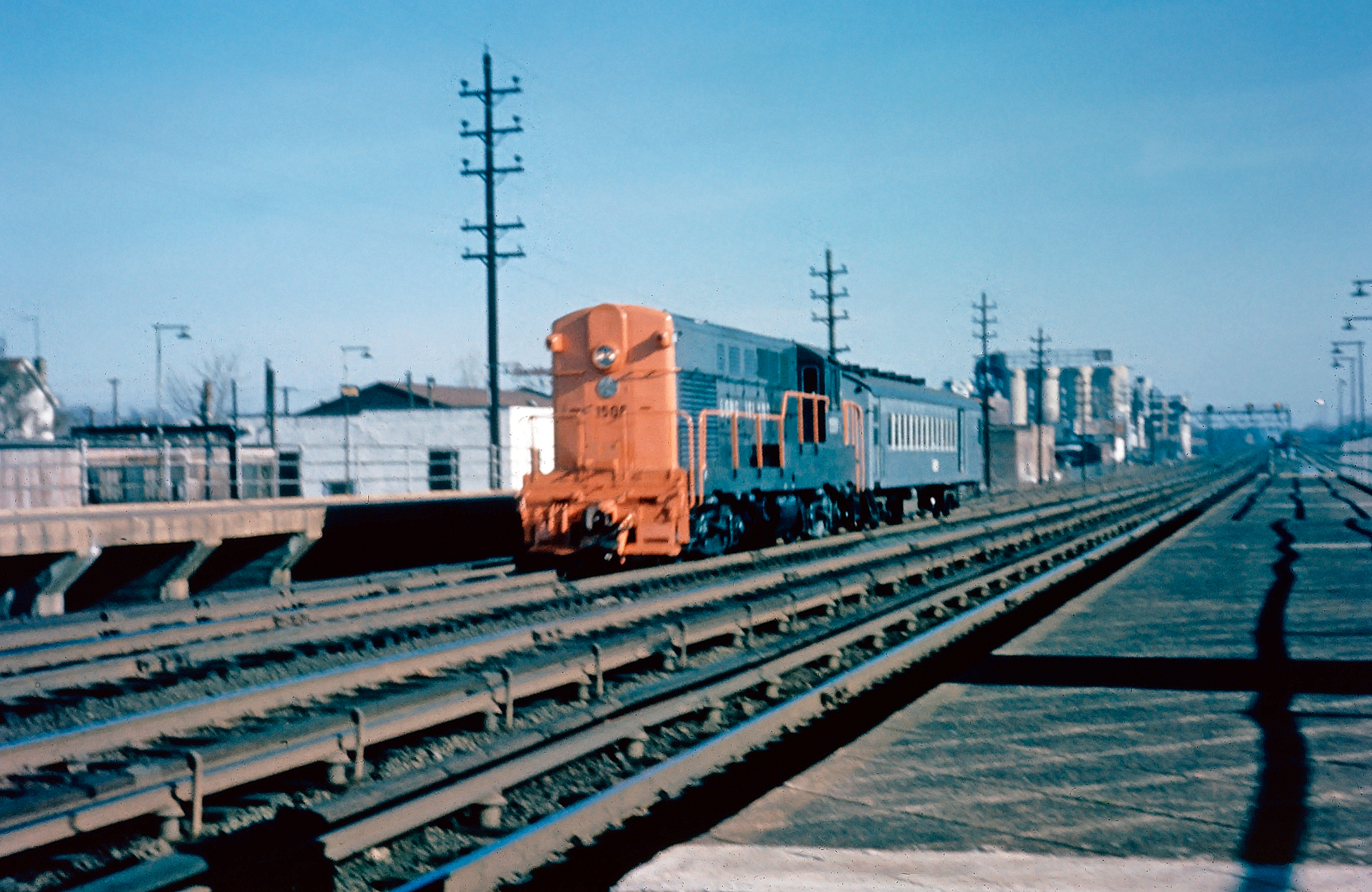 Long Island Rail Road H16-44 #1506 totes a single combine past the station at Hillside, New York, circa 1954. Meyer Pearlman photo. American-Rails.com collection.
Long Island Rail Road H16-44 #1506 totes a single combine past the station at Hillside, New York, circa 1954. Meyer Pearlman photo. American-Rails.com collection.By the 1990s, MTA was hoping to transfer its relatively small freight operations to a private company which would utilize trackage rights for the purpose of maintaining service.
According to Joe Greenstein's article, "Long Island's Freight Revival," from the May, 1999 issue of Trains Magazine, the newly-created New York & Atlantic Railway was contracted for this purpose, officially launching on May 12, 1997. The NY&A, a division of Anacostia & Pacific, uses its own freight cars and locomotives.
However, in addition to trackage rights, it is also granted permission to utilize the LIRR's shops and maintenance facilities.
It currently operates 269 miles of the LIRR system from Fresh Pond and Jamaica in the west to all of the major eastern termini including Port Jefferson, Montauk, and Southhold (just west of Greenport).
Finally, it snakes eastward to also serve Bay Ridge and Maspeth (Queens). Today, the NY&A handles about 28,000 carloads with 13 locomotives and 41 employees (up from just 8 locomotives and a few staff members when operations began).
Contents
Recent Articles
-
Gulf & Mississippi Railroad: The First Regional
Nov 22, 24 09:54 AM
The Gulf & Mississippi Railroad was the first regional railroad formed in the U.S. when Illinois Central Gulf spunoff 713 miles in 1985. It was acquired by MidSouth Rail in 1988. -
MidSouth Rail Corporation: An ICG Spinoff
Nov 22, 24 08:32 AM
MidSouth Rail was one of Illinois Central Gulf's many large spinoffs in the 1980s as the company attempted to streamline operations. It was acquired by Kansas City Southern in 1994. -
The Wrecking Derrick: Railroading's Unsung Hero
Nov 20, 24 12:35 PM
The wrecking derrick was once a vital piece of maintenance-of-way equipment, ensuring rail lines were quickly reopened following an accident or derailment.
